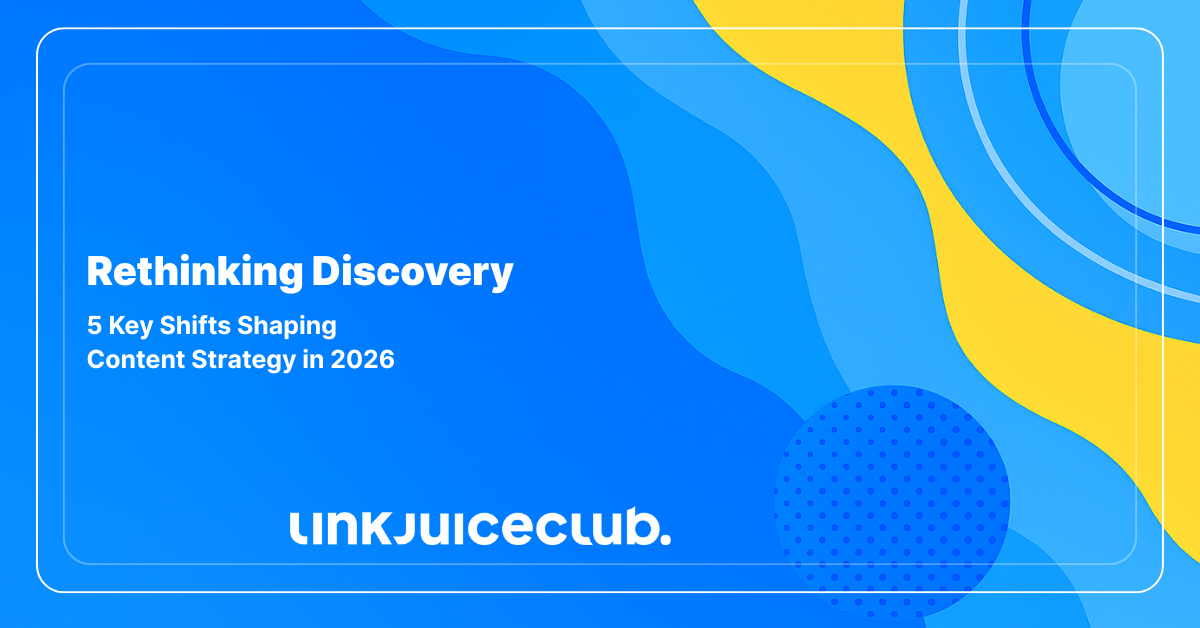
Rethinking Discovery: 5 Key Shifts Shaping Content Strategy in 2026
Crafting a successful content strategy in 2026 starts with meeting users in the spaces they already explore, engage, and rely on. Search is scattered, user behavior has shifted, and the old rules no longer move the needle.
The notion of a neat, linear search , one query, one link, one perfect answer , is long gone. Today, discovery flows across countless platforms, formats, and moments.
Discovery is now embedded in:
📱 A TikTok scroll that stops users mid-swipe
💬 A deep dive into a Reddit comment chain
⚡ Instant responses generated by AI summaries
🎥 Short-form bursts from Reels or YouTube Shorts catching fire
What’s driving the shift? Because answers are no longer hard to find. With AI summaries, smart SERP features, and LLM tools everywhere, instant information has become the default, not the differentiator.
Why Perspective and Creativity Win the Search Game
There was a point when SEOs operated like stock traders, churning out top-of-funnel pieces and banking on conversions down the line. That playbook doesn’t hold anymore. Information is everywhere, and answers are cheap.

Discovery no longer lives in the search bar. It’s embedded in culture — surfacing through memes, micro-communities, and fast-moving trends. Curiosity flows through feeds, and a single swipe in the right place can influence choices just as much as any typed query.
For brands, this isn’t disruption to fear, it’s an open door. The winners will be those who build a playbook, one that thrives on creativity, cultural relevance, and showing up wherever people turn for answers, proof, or inspiration.
1. Authority Is Earned Where Conversations Happen
By 2026, experience, expertise, authoritativeness, and trustworthiness isn’t proven with checklists — it’s earned in the wild. Credibility comes from showing up in the spaces where people are creating, sharing, and shaping the conversation. Reputation isn’t something you claim; it’s built through how audiences talk about and interact with your brand across every corner of the digital landscape.
Ten years back, a single backlink could build credibility. In 2026, authority is reflected in cultural signals — a stitch on TikTok, an upvoted Reddit thread, or a mention inside an LLM response. These markers now define reputation, which is why content strategy in 2026 must lean heavily on brand mentions, creator partnerships, and earned visibility beyond your own domain.
When trusted creators talk about your brand, it carries weight in both social and search ecosystems. The Google Search leak that occurred in 2024 confirmed one thing: engagement matters. Brand mentions, interactions, and social buzz now play a direct role in how Google measures authority and ranks content.
Brand-led publishing on its own doesn’t carry enough weight anymore. To thrive, content strategy in 2026 requires:
- 🤝 Creator collaborations that lend borrowed credibility
- 🗣️ Community engagement that sparks authentic conversation
- 👀 Earned visibility that travels further than your own channels
Creators now act as trust proxies, giving brands credibility by association and positioning them within culture, not just within search. That kind of relevance can’t be faked, and it’s fast becoming the competitive advantage.
🔑 Key Takeaway
In shaping content strategy in 2026, don’t just chase rankings, earn them through collaboration, social proof, and cultural presence. Authority now starts with visibility in the public square.
2. Formats Define Trust More Than Platforms Do
For years, SEO strategy started with a simple question: where?
- 🎥 Videos crafted for YouTube
That strategy won’t cut it in 2026. People now look for answers delivered in the format they naturally gravitate toward and feel confident engaging with. The platform is secondary. What matters most is matching the medium to the moment.
Take this scenario: someone searches “What’s it like to freelance in Lisbon?” If the top results are creator-led vlogs and quick TikTok or Reel snippets, publishing a long blog post won’t cut it. The content strategy in 2026 must align with user expectations for format first, then optimize for visibility.
The process begins with intent and format research, not just keywords. Ask yourself:
- 🖼️ Is this topic better suited to visuals, narratives, or quick-fire clips?
- 👥 Does the conversation lean toward community-driven creators or authoritative brand voices?
- 📊 Is it analytical, emotional, or tutorial-based?
Once you understand these nuances, you can design an editorial plan that mirrors how people already consume information and part with their attention. That’s what a format-first, intent-led approach looks like in action, and it’s the foundation of a winning content strategy in 2026.
🔑 Key Takeaway
Let intent and format guide every decision. Research how people want to consume information before deciding what to publish, and where.
3. SERPs Are Splintering — and That’s Your Opening
By 2026, search results won’t live in a single, neat SERP. They’ll splinter across a growing universe of discovery layers:
- 🤖 AI and LLM summaries
- 📌 Featured snippets
- 💰 Ads and sponsored results
…and plenty more surfaces still emerging
This fragmentation means “SERP dominance” no longer equals owning one blue link on one page. It’s about visibility across every surface where the query shows up, and then bringing those wins back into Google to reinforce authority.
SERP analysis now requires multi-platform intelligence. Instead of thinking “Google-only,” the smartest teams are mapping attention clusters: identifying the places and formats where audiences are actually engaging.
Ask yourself:
- 🎤 Do these queries surface creator-led content?
- 🗨️ Are forum responses or community discussions ranking?
- 🖼️ Does the search trigger visual-heavy results?
- 📊 Is there a featured snippet or AI Overview in play?
From there, build a SERP search universe map, a living guide to where your content needs to show up, how it should look, and which trust signals matter most on each surface.
When done right, this approach turns fragmentation into opportunity. Instead of spreading thin, you’re aligning format and placement with intent, then feeding that authority back into the ecosystem. It’s a smarter, more holistic way to shape content strategy in 2026.
🔑 Key Takeaway
Treat every SERP as an ecosystem, not a page. Track where queries live, from TikTok to Reddit to AI Overviews, and engineer tailored solutions for each.
4. Real-Time Signals Beat Static SEO Calendars
The strongest strategies in 2026 aren’t built on quarterly audits, they’re fueled by live data. With cultural cycles moving faster than ever, social trends reshaping discovery, and algorithms updating in real time, brands can’t afford to wait. They need always-on intelligence that tracks how, where, and why audiences are paying attention.
That means monitoring:
- 📈 SERP volatility across platforms
- 🎤 Creator performance and audience shifts
- 💬 Social signal spikes that drive conversation
- 🤖 LLM outputs that shape instant answers
This isn’t about buying more SEO tools or chasing the newest feature set. It’s about shifting to a new operating model where search and social data are baked into the daily workflow. The payoff? Predictive, adaptive strategies that move at the same speed as culture itself.
For forward-thinking teams, this agility is what defines content strategy in 2026. Static calendars are giving way to dynamic, intelligence-led planning that adjusts with the signals in front of you. Instead of reacting to what already happened, brands get to shape the narrative in real time.
🔑 Key Takeaway
Build your content strategy in 2026 around live search intelligence. Let real-time signals from search results, creators, and social platforms shape your publishing decisions, static content calendars just can’t keep up anymore.
5. AI Decides Your Visibility Before People Do
For a long time, content was crafted with people in mind, clear, engaging, and easy to navigate. But in 2026, your audience’s first encounter often happens through AI, not a direct visit.
Discovery is now filtered through AI layers, from Overviews and voice assistants to shopping guides and LLM-driven search. That means your content has to serve two audiences at once: humans and algorithms. It needs to be machine-scanned, ready, and trusted by AI layers that surface results.
Key questions to ask:
- 🧩 What parts of your content get cited in LLM responses?
- 🗣️ How do AI assistants train on your brand’s material?
- 📌 How is your brand being represented in AI-driven summaries or featured snippets on Google?
Many brands are still behind the curve, but this is where visibility will be won. To claim your space, you need to:
- 🗂️ Build structured, intent-focused pages
- 🤝 Invest in third-party validation, forums, creators, reviews
- 📊Track how your brand shows up across AI-powered answers, from summaries to voice results, make sure your presence is accurate and positive.
- ✍️ Write with clarity and structure, focus on summary-ready content that’s well-organized, machine-readable, and still speaks like a human.
🔑 Key Takeaway
Structure, clarity, and quotability are now table stakes. AI layers are the front door to your site, treat them like your first audience.
Discoverability Has to Be Engineered, Not Hoped For
“Search everywhere” isn’t hype — it’s the everyday reality of how people explore, compare, and decide which brands they’ll believe.
This evolution means content strategies can no longer rely on a patchwork of posts, clips, and one-off tactics. Discoverability now requires a system, one that’s built across multiple surfaces, aligned with user intent, format-conscious, and designed to capture attention wherever it flows.





